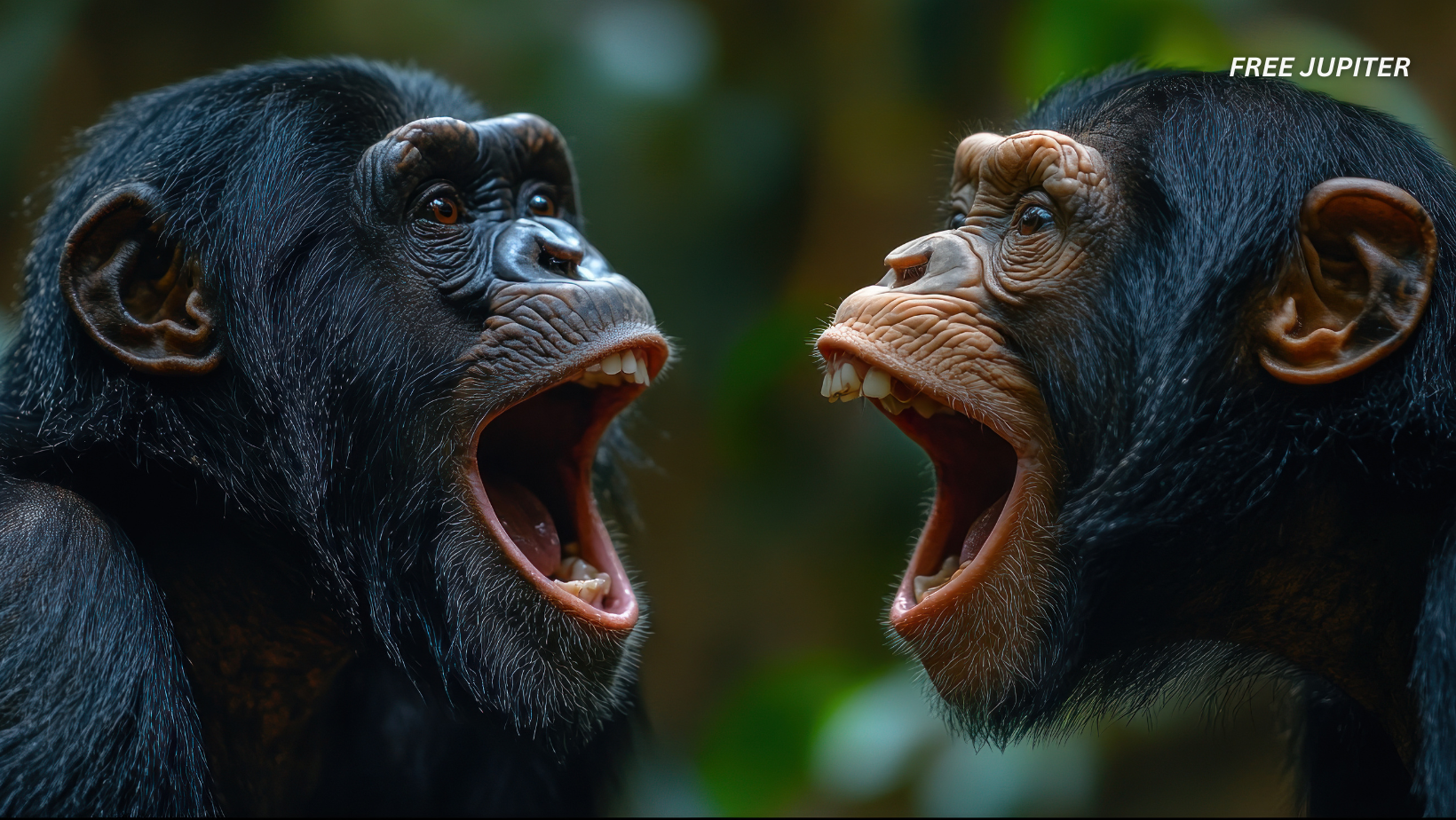Friendly Note: FreeJupiter.com shares general info for curious minds 🌟 Please fact-check all claims—and always check health matters with a professional 💙
In the forests of Côte d’Ivoire, something remarkable has been unfolding among the treetops: wild chimpanzees appear to be doing more than just hooting and grunting. According to recent findings from the Max Planck Institute for Evolutionary Anthropology, our primate cousins might be engaging in a form of vocal expression that bears unexpected similarities to the foundations of human language.
This isn’t just another cute animal behavior story. The researchers’ discovery could have profound implications for how we understand the origins of human speech, nudging us to reconsider what truly separates us from the animal kingdom.
A Jungle Full of Voices
Deep within Taï National Park, scientists spent years observing three different groups of chimpanzees. Armed with audio recorders and endless patience, they managed to capture over 4,000 vocalizations. Among these, 734 were combinations of two distinct call types — a figure that stood out.
Rather than simply cataloging the sounds, researchers also documented the contexts in which they were made. Were the chimps eating? Playing? Greeting others? Showing aggression? These scenarios offered clues about the social and emotional undercurrents behind each vocalization.
The idea was to see whether chimpanzees, like humans, could modify meaning by combining sounds — essentially stringing “words” together to form more nuanced messages. This kind of communicative layering is a key feature of human language, which uses structure and order to generate complex meaning.
Monkey Grammar? Maybe Not So Far-Fetched
Lead researcher Cédric Girard-Butto and his team discovered that chimpanzees don’t just toss out random sounds. Their combinations follow consistent patterns that mirror some of the basic principles found in human linguistic rules.
Take the “hoo” call, for example. On its own, it often signals something related to feeding. Then there’s “pant,” a sound more commonly used to express social connection. But when a chimp strings them together — “pant hoo” — the meaning appears to shift. This combo might indicate something closer to home-building or social bonding in a specific location.
In another case, a “grunt” typically tied to feeding, when followed by “hoo” (usually associated with resting), conveyed an entirely new scenario: feeding during a resting period. Importantly, reversing the order — “hoo grunt” instead of “grunt hoo” — changed the meaning. That detail suggests chimpanzees not only combine calls but also recognize how order impacts interpretation.
This sensitivity to structure — the idea that the arrangement of sounds affects their overall message — closely parallels one of the core mechanisms of human grammar.
Not Just Noise in the Trees
To make sense of all these patterns, the team turned to mathematical models. By analyzing how individual and combined sounds matched up with various social and environmental contexts, the researchers identified at least four consistent ways that the chimps modified meaning by blending calls.
In human language, combining units of sound to create layers of meaning is foundational. We don’t just rely on single words but create rich communication by using syntax — the arrangement of words and phrases. It now seems chimpanzees, too, might have the capacity for a rudimentary version of this.
What makes the discovery so striking is that, until now, vocal flexibility of this kind was thought to be a uniquely human trait. While previous studies had noted that apes could make a range of vocalizations, none had convincingly shown the presence of syntax-like rules — until now.
Rewinding the Evolutionary Clock
So what does this all mean for the story of human evolution?
The researchers propose that the building blocks of our language might go back much further than previously believed — possibly as far back as six to eight million years, when the last common ancestor of humans and chimpanzees roamed the Earth.
If that ancient ancestor already had the ability to combine individual sounds meaningfully, then the foundations of human language didn’t appear suddenly, but gradually emerged from a more primitive, yet structured, system of communication.
This idea challenges long-held assumptions that language emerged relatively abruptly in humans, and that non-human primates were stuck in a limited system of isolated vocal signals. Instead, it suggests a more continuous evolutionary path, where language evolved step by step from earlier communicative behaviors.
Read more: Bees Can Fly Higher Than Mount Everest – How High They Can Actually Go
So, Are Chimps Becoming More Human?
It’s tempting to frame this discovery as a sign that chimpanzees are slowly “becoming human,” but that would be oversimplifying. What’s actually unfolding is a clearer understanding of how close the cognitive abilities of great apes come to our own, at least in the realm of communication.
Rather than evolving “into” humans, chimpanzees are showing us that the roots of human language may not be uniquely ours at all. Our complex speech might have grown from seeds that were already planted long before our species appeared — seeds still flowering, in a different way, among our closest relatives.
A Question of Intelligence and Culture
The implications extend beyond linguistics. If chimpanzees are capable of using syntax-like structures, it also speaks volumes about their cognitive abilities and the richness of their social world.
Chimpanzees live in complex societies. They form alliances, share resources, resolve conflicts, and nurture relationships. It would make sense for such a socially advanced species to have developed more sophisticated ways to communicate. These findings support the idea that language didn’t evolve in a vacuum — it emerged to meet the growing demands of life in social groups.
Moreover, the variability between different chimpanzee groups hints at something even more intriguing: the presence of cultural differences. Some calls and combinations appeared more frequently in certain groups, suggesting that chimpanzee communities may develop their own “dialects” — just like humans do.
What Comes Next?
The study opens new doors for exploring the evolution of language. Future research might investigate whether other primates — such as bonobos, gorillas, or even certain monkey species — exhibit similar patterns in their vocal behavior. It may also be worth examining whether chimpanzees can learn entirely new sound combinations over time or even create novel ones.
There’s also the question of whether these calls serve purely functional purposes (like signaling food or danger), or whether they can express emotional or abstract states. If chimps can talk about what they feel, rather than just what they see, we’d be inching even closer to discovering the deeper layers of non-human consciousness.
Read more: New Research Traces Human Teeth Back to Fish Dermal Armor from 460 Million Years Ago
Final Thoughts: Echoes of Language Past
Far from being a whimsical tale of chattering apes, this study nudges us toward a deeper understanding of where we come from. Language didn’t suddenly appear with Homo sapiens. It may have started with creatures not so different from the chimpanzees of Taï Forest — creatures who, through small and gradual steps, developed the building blocks of what we now recognize as speech.
The jungle is not so silent after all. If we listen carefully, we might just hear echoes of our own distant past reverberating through the treetops — not in full sentences, perhaps, but in meaningful whispers shaped by millions of years of shared history.










